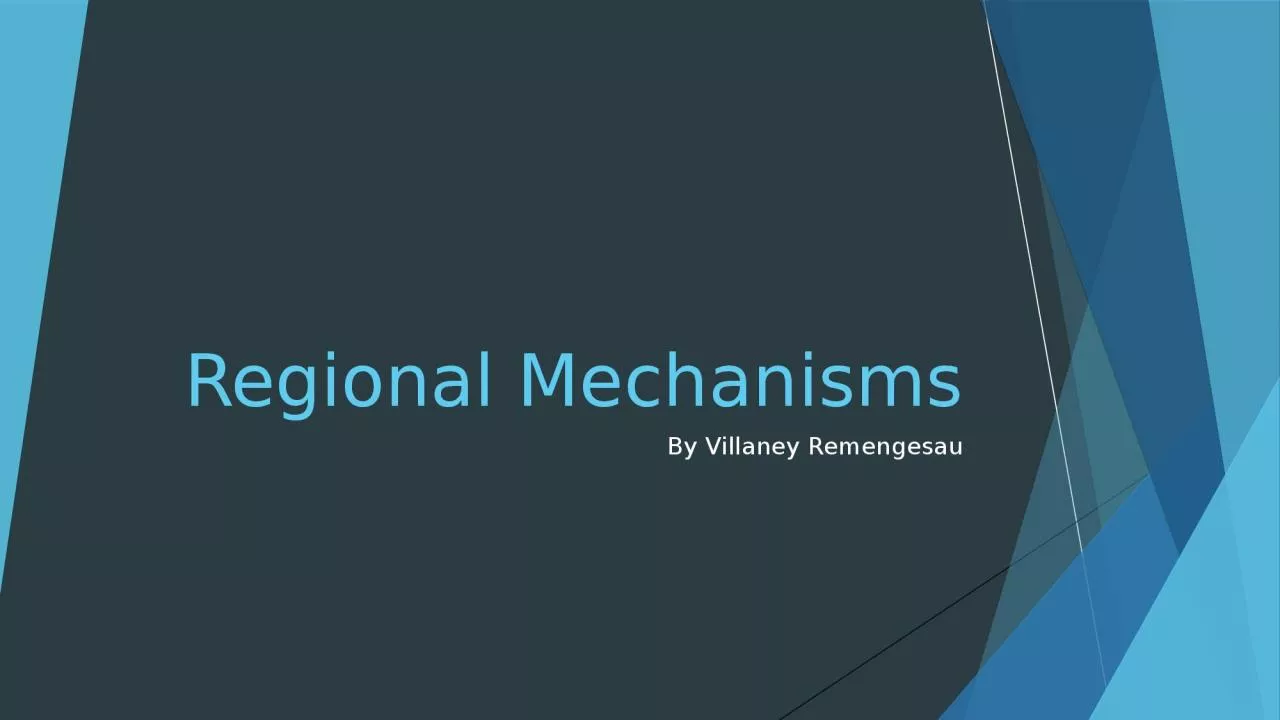

Background The Stakeholder Group of Persons with Disabilities SGPwD is the representative civil society body of persons with disabilities to the United Nations High Level Political Forum on the 2030 Agenda The ID: 1048193
Download Presentation The PPT/PDF document "By Villaney Remengesau Regional Mechanis..." is the property of its rightful owner. Permission is granted to download and print the materials on this web site for personal, non-commercial use only, and to display it on your personal computer provided you do not modify the materials and that you retain all copyright notices contained in the materials. By downloading content from our website, you accept the terms of this agreement.
1. By Villaney RemengesauRegional Mechanisms
2. BackgroundThe Stakeholder Group of Persons with Disabilities (SGPwD) is the representative civil society body of persons with disabilities to the United Nations High Level Political Forum on the 2030 Agenda. The SGPwD is a network of persons with disabilities, disabled persons organizations (DPOs) and other allies. The Asia Pacific is one of the five major global regions as defined by the United Nations. In the Asia-Pacific region, there is a strong and well-established coordination mechanism; the Asia-Pacific Regional Civil Society Engagement Mechanism (AP-RCEM).
3. What is APRCEM?APRCEM is a civil society platform aimed to enable stronger cross constituency coordination and ensure that voices of all subregions of Asia Pacific are heard in intergovernmental processes at the regional and global levels. It seeks to ensure that viewpoints and voices from all subregions of the Asia Pacific are represented and heard in intergovernmental processes in both regional and global levels. The AP-RCEM was started and is owned and driven by Civil Society Organizations. It seeks to engage with UN agencies and Member States, and it is designed to reach as many Civil Society Organizations in the region as it can in order to harness the voices of peoples’ movements and advance development justice that addresses issues such as inequalities of wealth, power, and resources, between countries, between the rich and poor, and between men and women.
4. Role of Asia Pacific Disability ConstituencyThe AP-RCEM engages in sustainable development processes and the Asia Pacific Disability Constituency is part of it. All activities of the APDC are organized in relation to Sustainable Development Goals (SDG) implementation and the Economic and Social Commission of the Asia Pacific (ESCAP) Sustainable Development Forum. Persons with disabilities as a regional stakeholder group have the rights to intervene, submit position papers and documents, hold side events and engage fully as a civil society stakeholder at the ESCAP Sustainable Development Forum and related events.
5. Objectives of Asia Pacific Disability ConstituencyThe key objectives are to raise awareness, to amplify advocacy efforts towards CRPD compliant SDG implementation, participate in regional UN and other processes and opportunities and to build our community and raise awareness. We hope to bring strong messages to the next regional Forum on Sustainable Development held by UN ESCAP as well as to create and build partnerships to further the implementation of the SDGs for persons with disabilities with Member States and other actors in the region.
6. Establishment of Asia Pacific Disability ConstituencyRole of Focal PointA key component of the organizational structure of the Constituency is the role of Focal Point and Regional Focal Point. The Focal Point share information and opportunities to coordinate joint messages and carry out advocacy outreach. The Focal Points ensure that the workstreams adhere to the text of the CRPD, the 2030 Agenda and other key documents.Membership and ParticipationIf you want to be part of the Asia Pacific Disability Constituency and receive information about the region, the implementation of the Sustainable Development Goals and on how to engage, we are inviting you to join the Asia-Pacific Disability Group Listserv! We will be using the listserv to disseminate information, coordinate joint messages, and correspond about important events. To join the listserv:Click on: https://groups.google.com/g/asia-pacific-disability-constituency-aprcem/membershipEmail tewai@visionpacific.org.nz or telesia.kobiti@pacificdisability.org to add you in the listserv. If you have any further questions, please feel free to contact the Focal Point at lanysmile85@gmail.com or la@visionpacific.org.nz.
7. Engagement and Structure of the Asia Pacific Disability ConstituencyEstablishment of Core GroupTitle of Working Group (WG)TasksAdvocacy Working GroupBuilding the membership, raising awareness in the region, drafting media messagesCapacity Building Working GroupEstablishing processes, overseeing selection, drafting speeches, interventions, reports, submissions, schedule of webinars, holding of thematic discussions Communications Working GroupRaise awareness about the constituency, build the listserv and invite people to join, sharing information about the work to ESCAP, APRCEM, and beyond, conduct a subject-specific time-bound campaign
8. Be a Subregional Focal Point Subregional Focal Points will carry out technical facilitation of Working Groups, organize meetings, and maintain official records of meetings, participants, and action steps. The subregional focal points will help to ensure that the Working Groups adhere to the text of the CRPD, the 2030 Agenda, and other key documents, and report to the regional focal point of the Asia Pacific.There will be elections for the Subregional Focal Points for the SGPwD in the subregional offices in the Asia Pacific. The offices are as follows: East and North-East Asia : China, Democratic People's Republic of Korea, Japan, Mongolia, Republic of Korea and Russian Federation. Associate members: Hong Kong and Macau;North and Central Asia : The Russian Federation, Azerbaijan, Kazakhstan, Kyrgyzstan, Tajikistan, Turkmenistan and Uzbekistan, Armenia, and Georgia;The Pacific : Australia, Fiji, Kiribati, Republic of the Marshall Islands, Micronesia (Federated States of), Nauru, New Zealand, Palau, Papua New Guinea, Samoa, Solomon Islands, Tokelau, Tonga, Tuvalu and Vanuatu. Associate members: American Samoa, the Cook Islands, French Polynesia, Guam, New Caledonia, Niue and the Commonwealth of the Northern Mariana Islands;South-east Asia : Indonesia, Thailand, Singapore, Malaysia, Philippines, Vietnam, Brunei, Cambodia, Myanmar (Burma), Laos;South and South-West Asia : Afghanistan, Bangladesh, Bhutan, India, the Islamic Republic of Iran, Maldives, Nepal, Pakistan, Sri Lanka and Turkey.
9. Lessons LearnedImprove communicationLearn from experienceOrganization/PrioritizationSupport and foster more cohesive teams